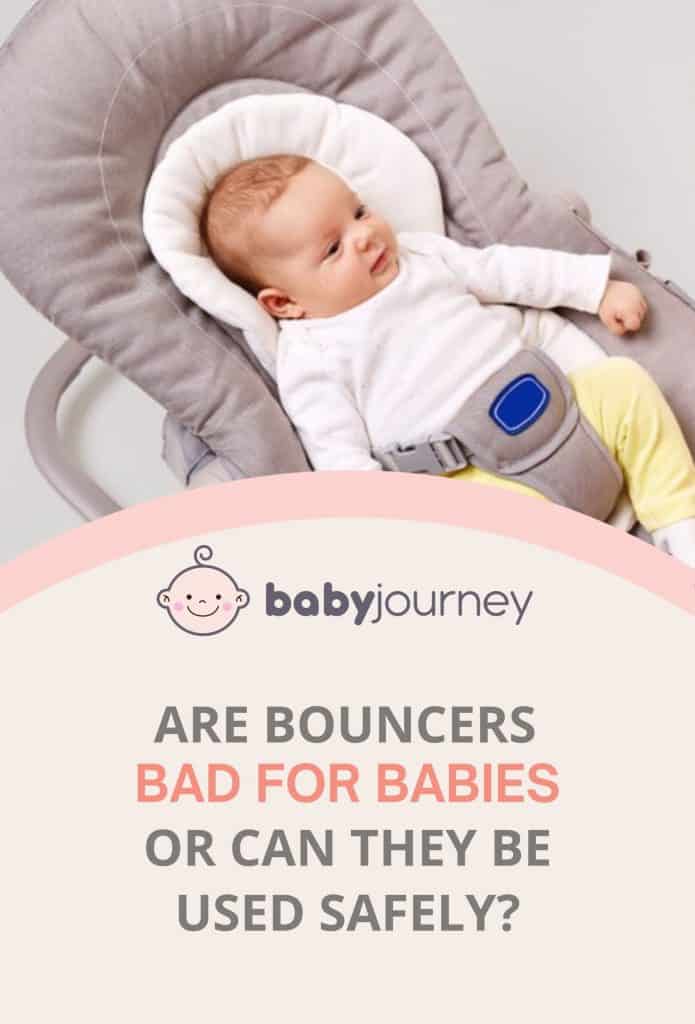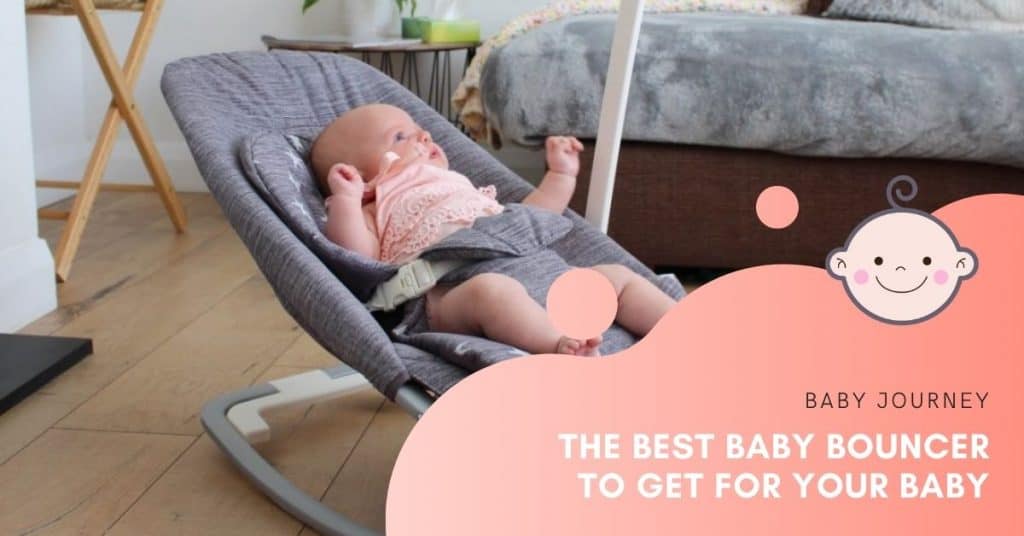Occasionally, baby activity bouncers will appear in the news. Usually, they are being scrutinized for a recall while the news hosts pose the question to parents, are bouncers bad for babies?
It’s very normal to be concerned with whether or not products are harmful to your children. You don’t want to use anything dangerous with your child, and you want to keep them safe. When it comes to baby bouncers, there are a few things parents should know. Knowing how to properly use an activity bouncer is key to making them safe for newborns and older babies alike.
Are Bouncers Bad for Babies?
Baby bouncers sometimes get a bad rap. However, many parents don’t have to be concerned with their safety as long as they use them properly and follow all manufacturer instructions. Starting with knowing the appropriate baby bouncy seat age and if your child meets the minimum and/or maximum.
When Can Babies Use a Bouncer?
Let’s start with the question “what is a bouncer?” This will help you understand the answer to when can a baby use a bouncer.

A baby bouncer usually consists of a soft, angled seat and a rigid frame. The seat is commonly made of fabric that forms a hammock-like shape when stretched around the frame. The seat also should include a three-point harness that straps around the waist and crotch.
Some baby play bouncers include accessories. This can be a motion and noise box that gently moves the bouncer automatically and plays songs or sounds. Bouncers may also include a mobile or toy attachments.
Other bouncers consist only of the seat and the frame. Either the baby’s movements or the parents cause these bouncers to bounce. Nearly all bouncers have a seat that extends past the child’s head. They may also have a neck and head support pillow.
Because of the gentle sloping nature of the seat and the high back, bouncers are suitable for most babies under thirty pounds. As long as you are within your bouncer’s manufacturer’s guidelines, your child is securely strapped in, and you are monitoring your child, the seat should be safe for newborns. [1]
However, there is some disagreement between those wondering “are baby bouncers safe for newborns?”. While some say that bouncers are meant for newborns, others believe that they should only be used with children between three and six months of age. [2]
The American Academy of Pediatrics, or AAP, does not explicitly state age recommendations for bouncers. Though they do indicate that children under four months of age are particularly at risk for suffocation. [3]
Once your child exceeds the maximum weight limit or can sit up on their own, you should stop using the bouncer. Many children begin sitting on their own at around six months.
If you are within the appropriate baby bouncers age, be sure you are following all bouncer guidelines for safe use.
Are Bouncers Safe For Babies?
Bouncing for babies has long been believed to be soothing. Many parents purchase a children’s bouncer so that their little one can have a calming place to rest while they do dishes, take a shower, or just get a few moments hands-free.
But as of late parents are left wondering, are baby bouncers safe? They have become controversial pieces of baby equipment due to reports of baby’s suffocating and even dying while using a bouncer.
Almost any piece of baby equipment can pose a risk to your child if it is not used properly or under proper supervision. If you follow all instructions provided by the manufacturer and constantly monitor your child, your little one should generally be safe in a baby bouncer. Also, baby bouncers are not meant for consistent use. Moderation is key and in certain situations, a baby bouncer is not recommended.
The Good and The Bad of Bouncy Seats
The question isn’t just are bouncers good for babies, but are they good for parents too? The answer is yes and no. Like everything in life, there are pros and cons.
Advantages Of A Baby Bouncer
When used properly, a baby bouncer is an enjoyable and safe place to set your child. This can help give parents a break to rest or take care of other things. It is important to understand that babies should not be left unsupervised in a bouncer, even if their parents are taking a break.
For young babies and newborns, a bouncer can have a calming effect. The gentle movements and soothing sounds mimic the movements they felt in the womb or feel in their parents’ arms. This means you can set them down without them fussing while you have a moment to yourself.
Bouncers can also help keep little ones engaged. If they have toys or mobiles a bouncer can present an opportunity for your child to work on their coordination and motor skills. If you choose a baby stand-up bouncer or a bouncer walker combo your baby can build their leg strength while they play.
Bouncers can be a great choice if you want to put your child down without having to lay them on the floor or leave them in their crib. They are comfortable, ultra-portable, and safe if used correctly.
Disadvantages of a Baby Bouncer
Most of the disadvantages of a baby bouncer have to do with improper use. Bouncers become dangerous when parents use them incorrectly and do not constantly supervise their child.
Parents may question, can my baby sleep in a bouncer? The answer is that babies should not sleep in a bouncer. Even if you are closely watching your child you may miss signs that they are having difficulties breathing.
The angled position of a bouncer seat can lead to SIDS, or sudden infant death syndrome. This is when the baby’s airway becomes obstructed, either from incorrect positioning of the head and neck or due to things like blankets or toys. Sleeping in a bouncer, especially overnight, is very hazardous.
Additionally, prolonged use of a bouncer may hurt the development of the baby’s head, neck, and torso. It does not give children an opportunity to strengthen their torso or neck muscles, which are necessary for sitting up on their own. Too much time in a bouncer can also cause flat head syndrome in which the back of the child’s skull becomes flattened.
Bouncers can be quite helpful, but if parents use them incorrectly they can also be quite dangerous.
Baby Bouncer Alternatives
If you have decided a baby bouncer is not for you, there are available alternatives.
A baby bouncer walker which is a seat that is less angled and attached to a rolling base will give your child less of an opportunity to sleep. This can lessen the risk of SIDS but walkers come with their own set of risks. Such as falling downstairs or tipping over.
Skipping bouncers altogether is an option. Pieces of baby equipment like an activity center, a play gym, or playmats can have a host of benefits with less risk. [4]

These types of equipment promote tummy time which is essential for your baby’s development. They usually include toys and accessories that can encourage motor skills, hand-eye coordination, and strengthening of the muscles.

Many parents find alternating between time spent in a baby bouncer and an activity center or play gym beneficial to both them and their child.
What I Do As A Mom: Tips To Bouncing Safely
If you do choose to use a bouncer, there are a few vital things to remember. The first is that your child should never sleep in the bouncer. Secondly, they should be constantly monitored by an adult. Finally, you must follow all instructions and warnings listed by the manufacturer.
To help you understand if you are using your bouncer safely, we have created a simple checklist. These steps may help minimize the risks of baby bouncers.
- Check that your child meets the weight and age limitations
- Ensure they are developmentally ready
- Follow safety guidelines, like never using a bouncer on a raised surface such as a bed
- Always supervise your child while they are in the bouncer
- Keep the bouncer on a flat and solid surface
- Stop using the bouncer when your child can sit unassisted or exceeds the weight limit
- Always follow the manufacturers’ instructions
Even if you follow all of these steps it is important to know that bouncers are never entirely risk-free. Use baby bouncers at your own discretion.
FAQs
How long can my baby stay in a bouncer?
Many bouncers come with specific guidelines, including age and weight recommendations. Most bouncers should not be used when your child can sit unassisted or exceed the weight recommendations.
Can baby bouncers cause brain damage?
Baby bouncers, if used properly, cannot cause brain damage. Lack of oxygen, such as if your child experienced difficulty due to a bouncer, may result in health issues like brain damage.
Is a baby bouncer good for a newborn?
Experts disagree on whether or not bouncer use is appropriate for newborns. Be sure to follow your equipment’s instructions and talk with your child’s pediatrician.
What should I consider when choosing a baby bouncer?
When choosing a bouncer, check the age range and weight limits to be sure they are suitable for your child. Next, look at the safety and comfort features. Does the bouncer have a belt or straps? Does it include head and neck support? Finally, decide if you want any extra accessories like toys or sounds.
What is the difference between a baby bouncer and a baby swing?
A baby bouncer consists of an angled seat on a rigid frame. A baby swing similarly has an angled seat but it is attached to a frame that allows it to swing back and forth.
Safety Is Key
If you want to use a baby bouncer with your child, you must do so properly to help keep your child safe. Follow vital recommendations like not letting them sleep in the bouncer, limit time spent in it, and always watch them closely.
Baby bouncers are not without disadvantages, but following all safety instructions and manufacturer guidelines can help decrease these risks. Hopefully, you found this answer helpful and feel better informed about the safety of baby bouncers.
—



